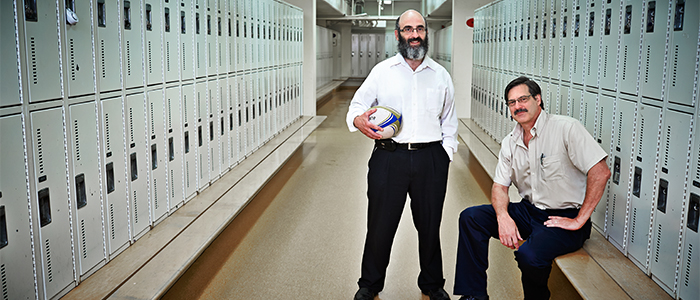Battling Concussion in the Locker Room and the Lab

Arthur Brown, PhD, and Greg Dekaban, PhD, are doing something BIG as part of a city-wide group studying everything from why concussions occur to how to prevent them
Robarts Research Institute scientists Arthur Brown, PhD, and Greg Dekaban, PhD, are thrilled to see that what started out as a phone call to the head of athletics at Western University has quickly snowballed into a city-wide, cross-disciplinary effort to understand concussions from every possible angle.
In order to get a clear picture of the impacts of concussion, they wanted to find a group of people who had a high probability of sustaining head injuries. By doing so, they could establish a baseline before they were injured and then be able to monitor the effects of the injury over a period of time.
“That’s when I picked up the phone and called Thérèse Quigley, who wasn’t a scientist or a physician; she was the Director of Sports and Recreation Services at Western,” said Brown. That phone call eventually led Dekaban and Brown to begin studying the women’s rugby team and was the impetus for the formation of a cross-disciplinary group.
The Brain Injury Group (BIG) London is comprised of more than two dozen professionals from across the city including physicians, scientists, educators and public health professionals interested in studying everything from the biomechanics of why concussions occur to how to prevent them.
“As our interests grew and our questions became more sophisticated, the group continued to expand,” Brown said. They quickly brought on imaging scientists like Robert Bartha, PhD, and Ravi Menon, PhD, to track the physical effects of the injury on the brain.
Using these brain images coupled with blood samples, they are aiming to pinpoint the physical changes in the body that occur with relation to concussion.
"When trying to understand if someone has a concussion or not, there isn’t one biomarker that helps to diagnose it. So looking at it from different angles and with different approaches is critical" - Greg Dekaban, PhD
Dr. Doug Fraser, a paediatric neurologist specializing in traumatic brain injury in children, has expanded the study to include adolescent hockey players. “We want to know who has an injury, how bad the injury is and what it means for them longterm,” Fraser said. “This information may also help us to identify when we can intervene and begin rehabilitation, and how, and to what intensity we can intervene.”
At the Fowler Kennedy Sport Medicine Clinic at Western University, Dr. Lisa Fischer, MD’93 and her colleagues saw just a few less than 1,900 concussion visits last year. Dr. Fischer says currently the diagnosis for concussion is done through understanding the mechanism of injury, and administering balance and neurocognitive testing. “Generally, someone with a concussion will have a normal physical exam,” she said. “So the diagnosis is more or less subjective. We need better objective measures, not only to improve diagnosis but to aid in recovery as well.”
And Fischer says in order to achieve this goal, it takes a whole team of experts. “We each bring our own expertise to the table, and when you bring it all together for a common goal, you are going to have a lot more success.”








